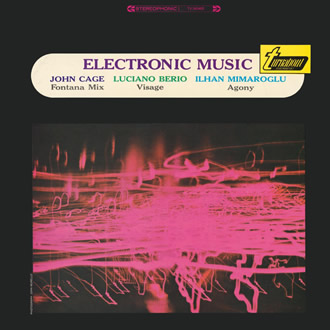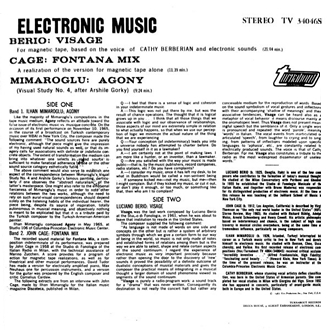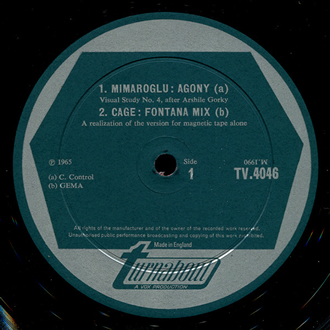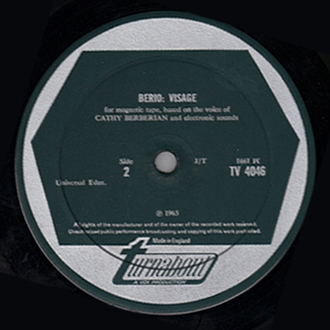- futura flash
- CONTACT US
- ELECONITC MUSIC

BERIO : VISAGE
For magnetic tape, based on the voice of CATHY BERBERIAN and electronic sounds
(21:04 min.)CAGE : FONTANA MIX
A realization of the version for magnetic tape alone
(11:39 min.)MIMAROGLU : AGONY
(Vi5ual Study No. 4, after Arshile Gorky)
(9:24 min.)SIDE ONE Band 1.
ILHAN MIMAROGLU: AGONY
Like the majority of Mimaroglu's compositions in the tape music medium, Agony reflects an attitude toward the false issue of electronic music vs. musique concrète. On the occasion of its first performance on November 10, 1965, in the course of a broadcast on Turkish contemporary music over WBAI in New York City, the composer made the following comment: "The sound sources here are purely electronic, although the piece might give the impression of my having used natural sounds as well, or that its imagery calls for associations with definite or indefinite concrete objects. The extent of transformation the medium can bring into whatever one selects as sound source is sufficient to make fanatical adherence to one or the other sound source category esthetically futile."
The above comment would also serve to establish one aspect of the correspondence between Mimaroglu's Visual Study No. 4 and Arshile Gorky's famous painting, particularly if one observes the ."abstract naturalism" of the latter's masterpiece. One might also refer to the emotional fierceness of Mimaroglu's music in order to note other relations between the two works, although the need to rely on such aural-visual correspondences should depend solely on the listening habits of the individual hearer, the piece being, despite its source of inspiration, totally autonomous in musical meaning, and objectively nothing is meant to be explicated but that it is a tribute paid by the Turkish composer to the Turkish-Armenian-American painter.
Ilhan Mimaroglu composed Agony in May 1965, at Studio 106 of Columbia-Princeton Electronic Music Center.
Band 2. JOHN CAGE: FONTANA MIX
The recorded sound material for Fontana Mix, a com-position indeterminate of its performance, was prepared by John Cage in 1958 at the Studio di Fonologia of the Italian Radio in Milan, with the technical assistance of Marino Zuccheri. A score provides for a program of action for magnetic tape realizations, as well as for theatrical and other musical performances. David Tudor has made a version for electrically amplified piano, Max Neuhaus one for percussion instruments, and a version for the guitar was prepared by the English composer and critic Cornelius Cardew.
The following extracts are from an interview with John Cage, made by Ilhan Mimaroglu for the Italian music magazine Discoteca, published in Milan.
Q. —1 feel that there is a sense of logic and cohesion in your indeterminate music.
A.—This logic was not put there by me, but was the result of chance operations. The thought that it is logical grows up in you . . . I think that all those things that we associate with logic and our observance of relationships, those aspects of our mind are extremely simple in relation to what actually happens, so that when we use our perception of logic we minimize the actual nature of the thing that we are experiencing.
Q.—Your conception (of indeterminacy) leads you into a universe nobody has attempted to charter before. Do you find yourself in it as a lawmaker? A.—I am certainly not at the point of making laws. I am more like a hunter, or an inventor, than a lawmaker.
Q.—Are you satisfied with the way your music is made public—that is, by the music publishers, record companies, radio stations, etc.? Do you have complaints?
A.—I consider my music, once it has left my desk, to be what in Buddhism would be called a non-sentient being ... If someone kicked me—not my music, but me—then I might complain. But if they kicked my music, or cut it out, or don't play it enough, or too much, or something like that, then who am Ito complain?

SIDE TWO
LUCIANO BERIO: VISAGE
Visage was the last work composed by Luciano Berio at the Studio di Fonologia, in 1961, when he was about to leave that institution to reside in the United States.
The composer supplied the following comment:
"As language is not made of words on one side and concepts on the other but is rather a system of arbitrary symbols through which we give a certain form to our way of being in the world, so music is not only made of notes and established forms of relations among them but is the way we are able to select, shape and relate certain aspects of the sound continuum. I regard the experience of electronic music as very important precisely because rather than opening the door to the discovery of 'new' sounds it proved the possibility of a definite outcome of dualistic conceptions of musical materials and gives the composer the practical means of integrating in a musical thought a larger domain of sound phenomena viewed as segments of the sound continuum.
"Visage is purely a radio-program work: a sound track for a "drama" that was never written. Consequently its destination is not really the concert hall but rather any conceivable medium for the reproduction of words Based on the sound symbolism of vocal gestures and inflections with their accompanying 'shadow of meanings' and their associative tendencies, Visage can be heard also as a metaphor of vocal behavior: it means discourse mainly at the onomatopeic level. Thus Visage does not present meaningful speech but the semblance of it. Only a single word is pronounced and repeated: the word 'parole', meaning 'words' in Italian. The vocal events from inarticulated or articulated 'speech', from laughter to crying and to singing, from patterns of inflections modeled upon specific languages to 'aphasia', etc., are constantly related to electrically produced sounds. The voice is that of Cathy Berberian. For me, Visage also constitutes a tribute to the radio as the most widespread disseminator of useless words."LUCIANO BERIO (b. 1925, Oneglia, Italy) is one of the few com-posers who contributes to the formation of today's musical thought. He studied at the Milan Conservatory with Peribeni and Ghedini. In 1955 he established the Studio di Fonologia Musicale of the Italian Radio, and (together with Bruno Maderna) was responsible for its distinguished production of electronic music. At the time of this release he was teaching at the Juilliard School of Music in New York City.
JOHN CAGE (b. 1912, Los Angeles, California) is described by Virgil Thomson as "the only real world leader in the United States" (HiFi/ Stereo Review, May 1965). He studied with Richard Bühlig, Adolph Weiss, Arnold Schoenberg and Henry Cowell. His artistic philosophy, based on indeterminacy and chance, is the subject of high controversy in musical circles everywhere, being at the same time of tremendous influence, particularly on young composers.
ILHAN MIMAROGLU (b. 1926, Istanbul, Turkey) interrupted his career as a Turkish music critic to live in New York and devote himself to electronic music. He studied with Beeson, Chou, Ussachevsky, and Varese. His first recorded release of electronic com-positions (Vox/Turnabout TV 4004/340045) received critical acclaim: "incredibly inventive . . ." (Alfred Frankenstein, High Fidelity); "fascinating aural beauty . . ." (Howard Klein, New York Times). At the time of the present release, he was an instructor at the Columbia-Princeton Electronic Music Center.
CATHY BERBERIAN, whose stunning vocal artistry defies classification, was born in the United States of Armenian parents. She completed her vocal studies in Milan with Giorgina del Vigo. Since 1953 she has appeared in concerts, particularly of avant-garde music, both in Europe and in the United States.